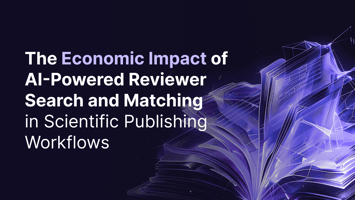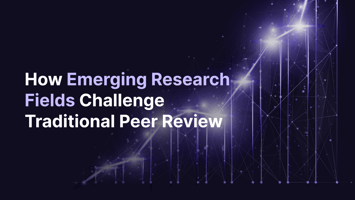When we sit down with scientific publishers and research funding agencies, the conversation...
How AI-Powered Peer Review Transforms Editorial Workflows: Real Client Experiences
What happens when editorial teams see their biggest operational bottleneck solved in under 60 seconds.
"They were so surprised how quickly and precisely Referee Finder can suggest relevant expertise, at the same time detecting hidden conflicts of interest, providing opportunities to diversify results in terms of gender, geography, and seniority level - all in under a minute."
This is Alexey Bykov, Prophy's Chief Business Development Officer, describing a recent client demonstration. The reaction that followed reveals something important about the current state of peer review:
"The room goes quiet for a second, for a few seconds. There's silence, and then they say, 'Wow! Yes, we are quite surprised.'"
That pause represents the moment when editorial teams realize their biggest operational bottleneck has a solution.
Understanding Client Pain Points
In demonstrations with publishers and funding agencies, the challenges are remarkably consistent. When asked "What are your top 3 pain points when looking for peer reviewers?" the responses follow predictable patterns:
Publishers consistently mention that manual workload is overwhelming their editorial teams, while conflict detection accuracy remains a persistent challenge. Meeting diversity requirements across submissions adds another layer of complexity to an already demanding process.
Funding agencies face different pressures. Privacy compliance requirements for sensitive grant information create operational constraints, while the need for multi-language support in international evaluations complicates reviewer selection. The complexity of reviewing interdisciplinary proposals presents the biggest challenge for most funding organizations.
These are limitations that impact the quality of scientific evaluation, not merely operational inefficiencies.
The Database Advantage
What consistently gets client attention is the comprehensive scope of Prophy's database: more than 178 million publications and over 86 million researcher profiles, collected from multiple sources including Crossref, PubMed, PMC, university repositories, and preprints.
The operational benefit becomes clear when clients learn the database updates every 24-48 hours. This isn't just impressive technology - it's reliability that editorial teams can depend on for current information.
Semantic Search vs. Traditional Keyword Matching
Here's where most existing solutions fall short: they search article titles only. Prophy's algorithm analyzes full text using semantic analysis, extracting hundreds of concepts instead of just keywords.
Why does this matter? Important concepts can be missed in titles but appear throughout the full text. This approach provides more relevant reviewer suggestions - and clients see immediate quality improvements in their recommendations.
Automatic Conflict Detection
The capability that consistently transforms skeptics into believers is automated conflict of interest detection. The system identifies co-authorship and common affiliations, showing exactly which authors have shared recent publications and institutional connections.
What makes this particularly valuable is the flexibility. Different organizations have different requirements, and they can adjust detection timeframes (3, 5, or 10 years) to match their specific compliance needs. Results appear in seconds rather than requiring manual verification.
Addressing Different Audience Needs
Publishers and funding agencies require different demonstration approaches based on their operational priorities.
Publishers focus primarily on integration capabilities. They want to understand how the solution works within existing editorial management systems like Editorial Manager or ScholarOne. The emphasis is on workflow efficiency and seamless adoption without disrupting established processes.
Funding agencies prioritize privacy and security above all else. Prophy has extensive experience with public tenders and security questionnaires, offering flexible privacy options including abstract-only uploads or concept-based searches for sensitive information. This addresses the confidentiality concerns that keep procurement teams engaged throughout the evaluation process.
The Author Group Feature
An unexpected benefit that generates positive reactions is the ability to integrate existing internal reviewer databases. Editorial teams can share their Excel-based reviewer lists, and Prophy matches them within the system.
This allows two approaches: internal search to find the best reviewer from existing databases according to Prophy scores, and hybrid results that show how internal reviewers rank alongside broader suggestions. This eliminates the need to rely on memory when managing thousands of reviewer contacts.
Advanced Filtering Capabilities
The system offers sophisticated filtering options that address common editorial challenges. Geographic diversity controls allow inclusion or exclusion of specific countries and regions. Gender balance filters ensure diverse reviewer teams. Seniority levels can be filtered by H-index, article count, or academic age. Institution type selection covers commercial, healthcare, or academic affiliations. Concept refinement allows boosting specific research areas for interdisciplinary manuscripts.
The Trial Process
Product demonstrations conclude with a practical next step: a 2-week free trial without obligations or user limitations. This allows editorial teams to test the system with their actual manuscripts and workflows.
The trial includes structured support through onboarding sessions for advanced features, Q&A sessions for specific use cases, and feedback discussions to address both positive results and limitations.
Implementation Results
Clients who actively engage during trials - uploading multiple manuscripts, attending scheduled calls, sharing specific use cases - typically see immediate operational improvements. The time savings translate directly to resource reallocation for higher-value editorial activities.
As one client noted: "My clients tell me they normally spend hours searching manually, and our product does it in seconds."
Strategic Implications
Successful implementations represent more than technology adoption - they enable editorial teams to focus on research quality evaluation rather than reviewer logistics. When conflict detection becomes automatic and reviewer discovery happens in minutes rather than hours, the entire editorial process becomes more efficient.
The transformation isn't just about speed. It's about consistent quality, reduced bias, and improved diversity in peer review processes.
To see how these capabilities apply to your specific editorial workflow, schedule a demonstration focused on your current challenges and operational requirements.
.png?width=337&height=96&name=Logo%20(1).png)





